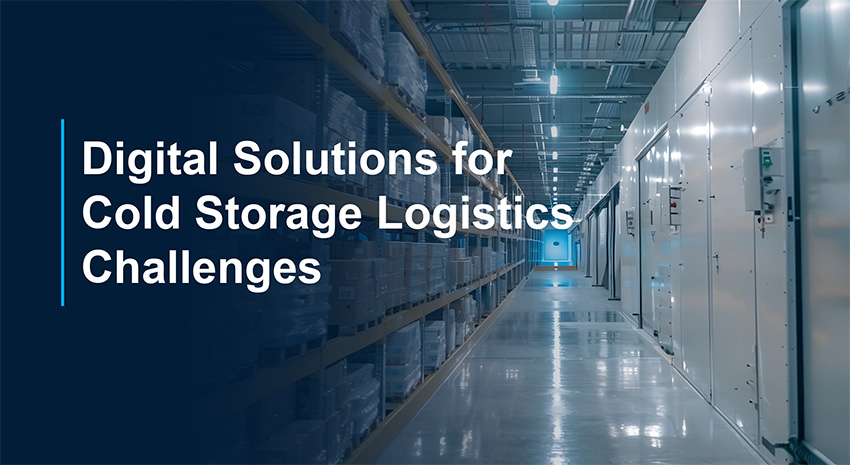The Big Chill: Managing Technology Challenges in Cold Storage Logistics

Whether transporting fresh seafood, frozen produce, or pharmaceuticals, cold storage logistics providers must balance speed, accuracy, and temperature control. While advancements in automation and the Internet of Things (IoT) are helping to modernize the cold chain, many providers still grapple with significant technology challenges that threaten profitability, compliance, and customer satisfaction.
Real-time temperature monitoring is the first line of defense
Maintaining product integrity starts with ensuring goods stay within tightly defined temperature ranges. Yet, many providers still rely on outdated or disconnected monitoring systems. Without real-time visibility, a refrigeration failure might not be discovered until it’s too late, resulting in spoilage and loss.
Modern solutions, such as IoT sensors linked directly to warehouse management systems, are designed to alert personnel when temperatures deviate from safe levels. However, the integration of these systems is not always straightforward. Providers need modern platforms that can seamlessly combine hardware and software, capturing data and triggering alerts instantly.
Overcoming the legacy system dilemma
Legacy systems remain a common pain point in cold storage logistics. Aging warehouse management systems (WMS), transportation management systems (TMS), and Enterprise Resource Planning (ERP) platforms often lack the flexibility or interoperability required in today’s fast-paced, interconnected logistics networks.
For cold storage providers, the inability to integrate these systems can mean manual data entry, duplication of effort, blind spots in reporting, and poor coordination across teams. Upgrading to cloud-based platforms that support modern Application Programming Interfaces (APIs) and Electronic Data Interchange (EDI) can drastically reduce these issues, enabling real-time data sharing between partners and systems.
Outdated ERP and WMS platforms aren’t ready for cold storage logistics
Standard WMS solutions may work fine in ambient warehouses but often fall short when used in temperature-controlled environments. Cold storage facilities frequently feature multiple zones—from chilled to deep frozen—each requiring different handling, tracking, and documentation protocols.
Providers need ERP and WMS systems that are built for cold chain logistics with features such as zone-specific inventory control, expiration tracking capable of handling First-In-First-Out (FIFO) or First-Expired-First-Out (FEFO) logic, and tools to manage complex customer requirements like temperature validation during outbound scanning. Customers increasingly want their providers to demonstrate this level of control and accuracy.
Lack of real-time visibility across operations
Today’s customers, especially in industries like grocery and pharmaceuticals, expect full visibility into inventory, shipments, and performance metrics. Unfortunately, many cold storage providers struggle to meet these expectations due to fragmented systems and delayed data updates.
Real-time dashboards, mobile barcode scanners, and RFID integration are key enablers for operational visibility. These tools allow workers on the warehouse floor to capture and transmit data instantly, keeping inventory records accurate and customer portals up to date. The result is fewer errors, greater customer satisfaction, and reduced manual reconciliation work.
Cybersecurity in an increasingly connected world
As systems become more connected and reliant on real-time data, they also become more vulnerable to cybercriminals. Cold storage providers, particularly those that handle pharmaceuticals or sensitive food products, are attractive targets for ransomware and cyberattacks.
Unfortunately, legacy systems often have outdated security protocols. Even when software updates and security patches are available, they are not always applied in a timely manner, creating vulnerabilities for the company and its customers, vendors, and partners.
Adopting a Zero-Trust security model, encryption, multi-factor authentication, and compliance with frameworks such as ISO 27001 are essential defenses against potential cyberattacks.
Staying audit-ready with automated compliance
Cold storage logistics providers must comply with strict industry regulations—like the FDA’s Food Safety Modernization Act (FSMA) or the Hazard Analysis and Critical Control Points (HACCP) standards. These regulations require detailed recordkeeping, traceability, and the ability to produce documentation on demand.
Manual processes are error-prone and time-consuming, especially during audits. Providers need ERP and WMS solutions that automatically log critical events, maintain audit trails, and provide digital documentation at the click of a button. Automated compliance not only reduces audit risk—it also improves operational discipline.
Scaling for seasonal peaks and growth
Cold storage logistics providers can experience spikes in demand due to holiday seasons or harvest cycles. Others experiencing rapid expansion need to onboard new customers or product lines quickly, and rigid, legacy infrastructure can’t keep up.
Scalable cloud platforms allow businesses to scale capacity as needed without the costs and delays of installing new hardware or re-engineering processes. Providers should look for modular, subscription-based solutions to grow alongside their business and adapt to evolving customer demands.
Leveraging automation and AI
Modern, cloud-based business applications provide tools to automate repetitive tasks, minimize errors introduced by manual processes, and increase staff productivity.
The addition of Artificial Intelligence (AI) allows companies to aggregate and analyze data from multiple systems within the organization to help management optimize warehouse operations, create accurate forecasts, and provide predictive insights into customer behavior.
Bridging the IT skills gap
Finally, many cold storage logistics firms lack dedicated IT teams, making them vulnerable when systems fail or upgrades are needed.
One solution is partnering with a managed IT service provider that understands logistics. Outsourced IT support can ensure consistent system performance, cybersecurity compliance, service continuity, and the implementation of new technologies without overstretching internal resources.
Ready to tame your tech challenges?
Cold storage logistics providers that invest in modern, integrated, and secure digital systems are far better positioned to reduce risk, enhance efficiency, and exceed customer expectations.
At ArcherPoint, we understand the unique demands of cold storage logistics. Whether you’re looking to modernize your warehouse management system, improve real-time visibility, or ensure compliance with evolving regulations, we can help you implement technology that keeps your operations efficient, compliant, and profitable.
Contact ArcherPoint by Cherry Bekaert today, and let’s talk about how Microsoft Dynamics 365 Business Central, Boltrics 3PL Dynamics, and a purpose-built digital strategy can transform your cold chain logistics.
Trending Posts
Stay Informed
Choose Your Preferences
"*required" indicates required fields
